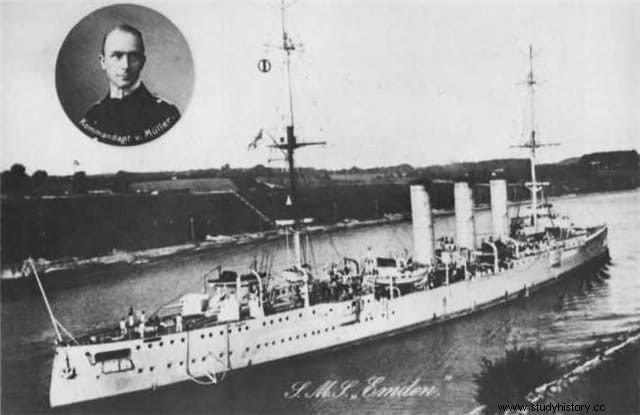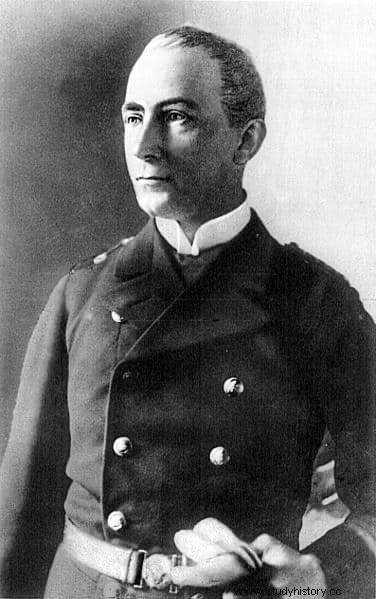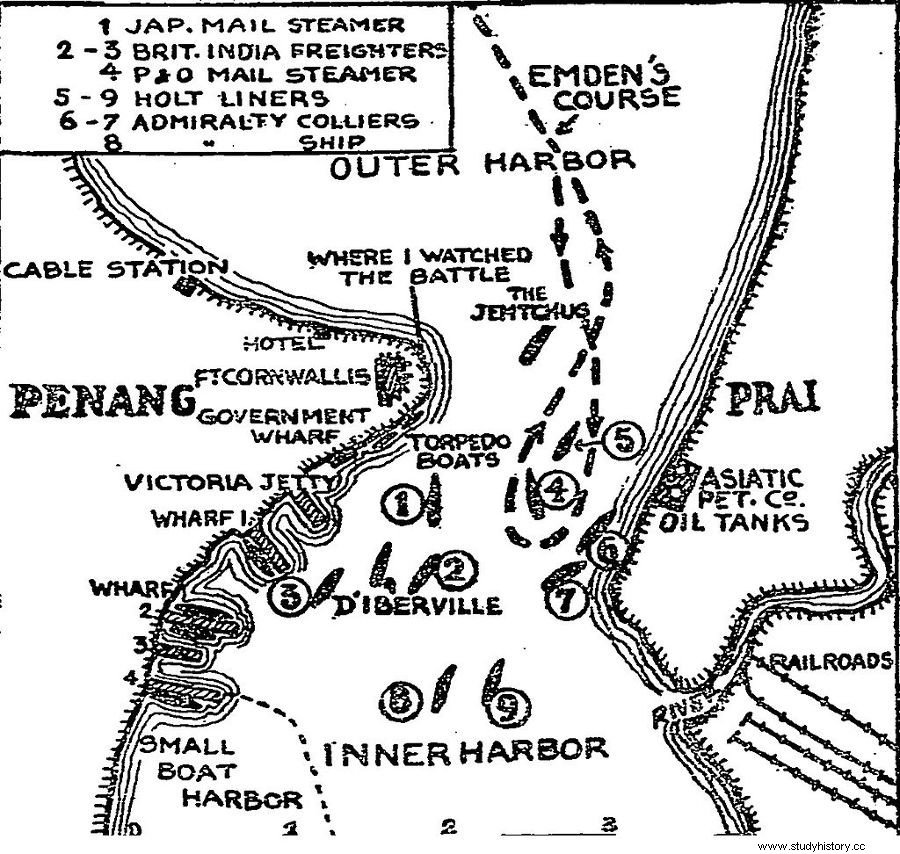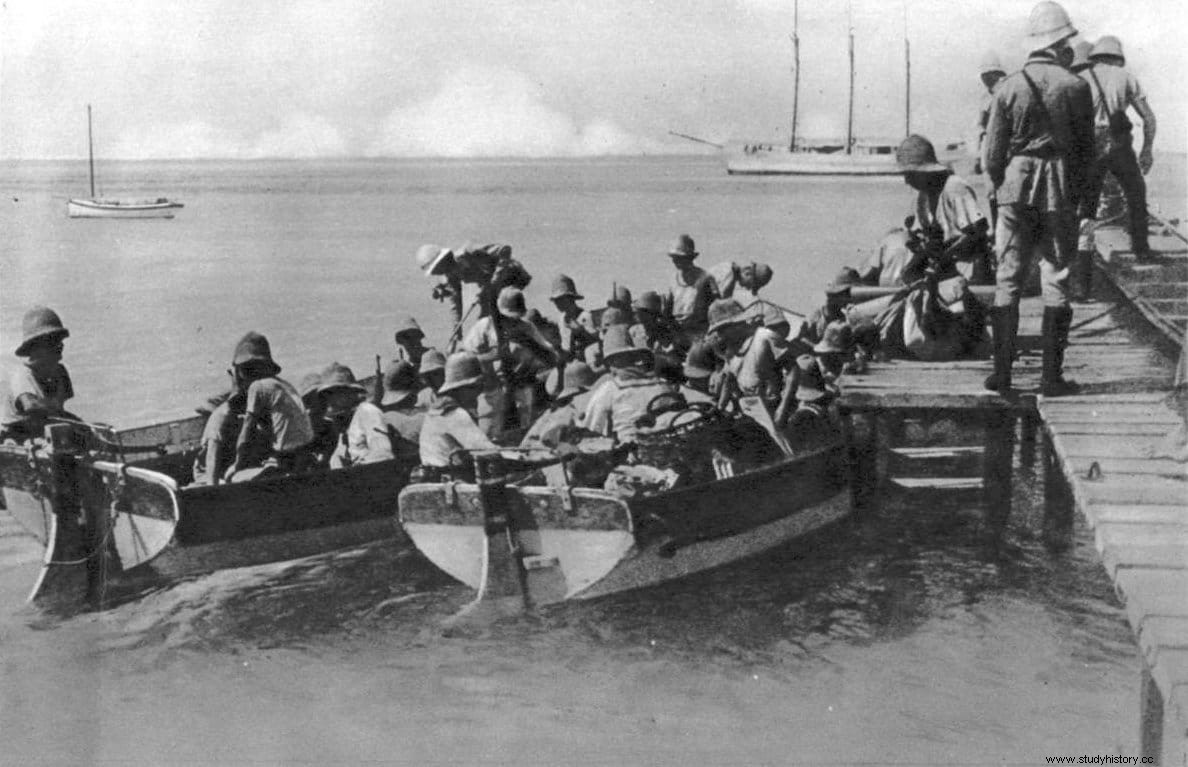The other day we saw here the adventures of Felix Graf von Luckner, a German sailor with a bizarre life who practiced privateering aboard a sailboat during the First World War. Today we are going to tell another no less eventful story that also happened during that war and, likewise, began aboard a corsair ship of the German Imperial Navy, the SMS Emden , although the most unusual episode, starring his first officer and several sailors, would take place on land:Helmuth von Mücke's odyssey.
Von Mücke was born in Zwickau (Saxony) in 1881, the same year as Luckner and, like him, into a blue-blooded family. Only, in his case, it was bankrupt and young Helmuth had to find a professional future. He found it in the Kaiserliche Marine , which he entered in 1900, graduating and serving over the next several years on the battleship SMS Kaiser-Friedrich III until in 1910 he received his first command, already as a lieutenant:the torpedo boat S-149 .
From there he became first officer of the light cruiser SMS Emden , a 118-meter-long, 3,364-ton ship launched in 1908 that had a sister ship, the SMS Dresden , from which it differed only in that it had a turbine engine -more modern- compared to the piston of the Emden . In the same year that Von Mücke assumed command of the torpedo boat, the cruiser was assigned as a member of the Ostasiengeschwader (East Asia Squadron) to Tsingtao, then a German protectorate in China and the main naval base of the Kaiser's navy in the East (an important trace of the German past remains in architecture and popular culture).

The reason for sending the ship there was to collaborate in the suppression of the rebellion of the Sokehs of Ponapé, that territory of Micronesia that Spain had sold to Germany along with the Carolinas and the Marianas in 1899 for 25 million pesetas to prevent the United States from they were taken away in the Treaty of Paris. The Sokehs had killed a number of Teutonic officials, dissatisfied with the colonial administration forcing them to pay taxes in the form of hard labor several days a year. The repression was relentless, executing the ringleaders, sentencing the participants to prison, and exiling half a thousand natives from Ponapé.
But in 1914 a much more serious problem would arrive:the imminent outbreak of the First World War. The commander of the Emden , Karl von Müller, received the news in advance and sailed to the Yellow Sea to meet on the island of Pagán (Marianas archipelago) with the fleet of Vice Admiral Maximilian Reichsgraf von Spee. Müller was a Prussian officer turned sailor, something common in the last quarter of the 19th century, and he had extensive experience having served first in several assignments (one of them in East Africa, where he contracted malaria that never left him) and later , already with the Emden under his command, in various successful actions for China that gave him great prestige.

It was then that Helmuth von Mücke was also assigned to that ship and when Müller was informed that, given the characteristics of his ship, he would have to practice a privateering war in the Indian Ocean. The objective was to distract the British and allow the East Asia Squadron commanded by Spee to operate with some relief, which was heading to South America and needed to have its rear guard protected. Thus, while the armored cruisers Scharnhorst and Gneisenau and light cruisers Nürnberg and Leipzig crossed the Pacific, the Emden she took the opposite course.
On August 4, the first prize was taken from her, a Russian-flagged mail steamer called Ryazan; she did not sink it but captured it and brought it to the port of Tsingtao. She later returned to sea accompanied by the auxiliary cruiser Cormoran and the great tit Markomannia , ready to hamper British shipping lanes as much as possible. On September 5, having disguised his ship and brandishing the Union Jack, Müller entered the Bay of Bengal capturing a Colombian merchant ship which he then hired for himself along with another captured ship, the Kabinga , while sinking four more.
During the following weeks the triumphant actions of the German corsair continued, not only accumulating prey one after another until adding thirty but even bombing Madras to destroy the numerous oil tanks that were in the port and leave the British ships without fuel; indeed, with this it managed to seriously reduce the transport through the Indian Ocean. The raids of the Emden They continued throughout September and at the end, also about to run out of her reserves, she landed in the Maldives to coal.

Days later he arrived at Diego García, an island in the Chagos archipelgo in the middle of nowhere that belonged to the British Empire but had not received notice of the state of war, so he warmly received the Germans and entertained them for a couple of days while the boat was being careened, probably with contained joke.
Then out to sea again, making prey one after another until mid-October, when Müller decided to change gears and made a daring night attack on Penang, Malaysia, where he torpedoed the Russian cruiser Zhemchug , which was tied up in her port making repairs. The flames that engulfed the Zhemchug Before blowing it up, taking eighty lives - including more than fifty Chinese prostitutes who were working on board - they also hit two French ships anchored alongside, an obsolete cruiser and a destroyer. The Emden She was already retreating when she came across a freighter that she proceeded to seize and another Gallic destroyer that she sent to the bottom.
Müller had not been able to avoid causing fatalities, as his colleague Luckner did, but he always picked up the sailors from the water and this time was no exception, leaving them on a merchant ship that he intercepted with the promise not to fight again in what was left. of war. However, the catastrophic consequences of the Madras and Penang actions determined the British to throw in the rest to put an end to that nuisance, against which up to 78 Triple Entente units had already been mobilized.

The final scenario would be located in the Cocos Islands, a group of coral atolls located between Australia and Sri Lanka where there was a radiotelegraph station that Müller proposed to destroy to cut off enemy communications in half of Oceania. A command of fifty men under the command of First Officer Mücke carried out the operation on the night of November 8. But before doing so, the operators were able to send an SOS that was received by the Australian cruiser HMAS Sidney . This ship turned out to be much closer than the Germans had estimated and showed up unexpectedly in the morning.
The Emden she weighed anchor and took on the Sidney but the latter's cannons had a greater range and it was enough for him to keep his distance to destroy the Teutonic ship in half an hour, which with serious damage, without a rudder, and with casualties totaling 134 dead and 69 wounded, ended up surrendering and running aground in a shallow to facilitate the evacuation of the crew. Initially, the Australians left them abandoned, but later came back for them and even allowed Müller to keep his sword for his courage; he was transferred to the United Kingdom while his family was interned in a prison camp in Malta.

However, one loose end remained:Mücke's detachment, which was still on the island and had watched the heavy fighting expectantly. Seeing what the outcome was going to be, they seized a dilapidated 97-ton sailboat named Ayesha with which they put the sea in between and fled to Padang, in the Dutch East Indies, at the beginning of an incredible odyssey:with the bilge pumps continuously running and without drinking water on board, they reached their goal on December 14 and the German consul made it easy for them to contact the Choising , a freighter from your country en route to Yemen.
There they landed with the idea of taking a train to cross Turkey but it turned out that the railway line was unfinished in that area. Despite the fact that they were allies, they were held for several months by the Ottomans, many of them becoming ill due to the poor conditions in which they were kept until Mücke made the decision to start up again with or without permission. The group left the port, crossed the mountains and reached the city of Sanaa (current Yemeni capital). The authorities detained them again but they took the opportunity to recover, although one could not overcome malaria.

A retired Turkish military man lent them money to rent a couple of feluccas with which they sailed to Kunfiddah, not without losing one along the way. It was the spring of 1915 and since it seemed impossible to continue by sea, they decided to try it through Arabia. It was not a route without danger, considering that the Bedouins had taken up arms against the Ottoman Empire and, in fact, along the way they had to fight several times, three sailors and a lieutenant dying. Fearing being taken prisoner by Sheikh Abdullah, they deviated from their goal, which was Mecca, to purchase a boat and reach Al Wajh on April 9. From there they were finally able to take a train that, crossing Syria, left them in Constantinople on May 23, just at the end of the failed Allied landing in Gallipoli, receiving a warm welcome.
They set foot in Germany again on June 5, where Von Mücke was given the hero treatment; not only for having led that unheard of trip but also for doing it with only six casualties. Of course, half of the survivors would die in the war over the following years. It was not the case of the officer, who took advantage of his newly gained prestige to retire; the war had been a bitter experience for him and he became a convinced pacifist who captured that position in two books (Emden and Ayesha) in which he recounted his adventures and which were quite successful in the US, where his wife was from.
However, like many veterans, the humiliation of the Treaty of Versailles led him to join the NSDAP (National Socialist German Workers' Party) in 1920, entering active politics. He did not last long in it because nine years later, frightened by the drift that the party was taking, he resigned and even became an opponent of Nazism; that meant a life sentence in 1933. Entered successively in the concentration camps of Kiel and Hamburg, he was released in 1939 due to his delicate state of health and due to his service record. He passed away in 1957; to the captain of him in the Emden , Karl von Müller, had been killed by malaria in 1923.
